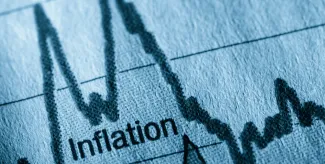
Inflation cooled in September
All signs pointed to potential trouble.
Sticky inflation. Tariffs heating up. Energy costs on the rise.
Economists warned that the next inflation report would signal surging prices and stall any hope of a rate cut.
But then the numbers came in, and they told a different story.
Prices did rise in September, but not as much as expected. In fact, the report showed signs of cooling across several key categories.
That’s a rare moment of relief for investors, policymakers, and anyone trying to stay financially grounded in a volatile year.
Why?
Recently, the Bureau of Labor Statistics dropped one of the only official economic reports we’ve seen since the government shutdown began: the September inflation data.
The takeaway? Inflation is still rising…but more slowly than expected.
Consumer prices ticked up 0.3% last month, bringing the annual rate to 3%. Core inflation, which strips out food and energy, also eased a bit.1
Gas prices spiked, and food costs crept higher, but those looked more like outliers than the norm. Most prices stayed relatively steady, hinting that the recent inflation surge may be losing steam.1
Wall Street initially responded positively.
Stocks surged, with each of the major indices ending the day at record highs. Add in better-than-expected corporate earnings, and markets closed the week with a wave of optimism heading into the Fed’s latest rate decision.2
In other words, analysts braced for a blowout. But the numbers came in cooler than expected.
Inflation’s still rising, just not as fast. And that’s what the Fed’s been aiming for.
The softer inflation data gives Fed Chair Jerome Powell some breathing room. He’s been trying to cool inflation without slowing the economy too much. At the most recent meeting (October 28th-29th), the Fed cut rates by 0.25% but emphasized this doesn't guarantee a December cut, with officials wanting to see more data.3 This inflation data provides one piece of the puzzle as the Fed weighs future policy adjustments.
Why does that matter? Because lower interest rates can ripple through the economy in ways that may affect your financial life:
- Borrowing could get cheaper. When rates come down, you might see some relief on mortgages, auto loans, or credit card balances.
- Businesses may catch a tailwind. Lower rates can help companies invest, hire, and grow…supporting the broader economy.
- Market reactions can vary. While rate cuts have historically supported markets in some conditions, the response depends on many factors including economic context and future policy expectations. Past performance doesn't guarantee future results, and volatility is always possible.
- Yields on CDs and savings accounts may dip. When the Federal Reserve cuts interest rates, banks usually respond quickly by slashing payouts on CDs and savings accounts.
- The U.S. dollar might dip. Lower interest rates usually, though not always, clip the U.S. dollar. A weaker greenback makes American-made goods more affordable abroad, which helps exports. But it could also make international travel more expensive if you’re planning a trip.
There’s one more ripple effect to note, especially for retirees. The government uses the same inflation data in this report to calculate cost-of-living adjustments, or COLAs, for Social Security.
Following the recent release, the Social Security Administration announced a 2.8% COLA for 2026. That means benefit payments will get a modest bump starting in January…a welcome boost for millions of retirees trying to keep pace with rising costs.4
This inflation report had the potential to rattle nerves. And with prices still elevated, that concern was valid.
The numbers confirmed what matters for planning purposes: inflation is moderating, not accelerating. Markets reflected this in their pricing. And the Fed maintained flexibility for its next moves.
These are data points, not turning points. But they help us understand the environment we're navigating.
P.S. Inflation, interest rates, market moves: they’re all connected. But what really matters is how they affect you.
Your financial life should give you clarity and confidence, regardless of what's making headlines.
Source:
1. Bureau of Labor Statistics, 2025 [URL: https://www.bls.gov/news.
2. Reuters, 2025 [URL: https://www.reuters.com/
3. CNBC, 2025 [URL: https://www.cnbc.com/2025/10/
4. Social Security Administration, 2025 [URL: https://www.ssa.gov/cola/].

